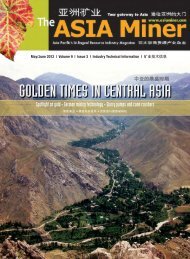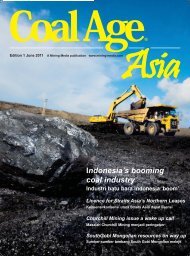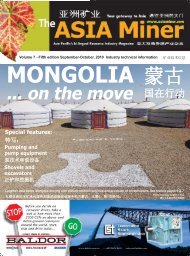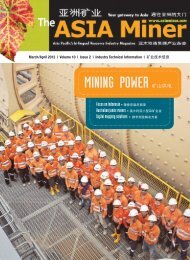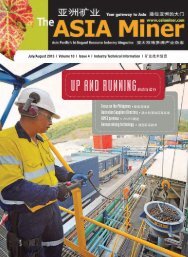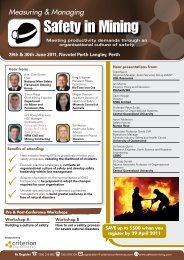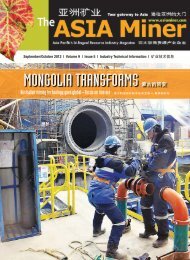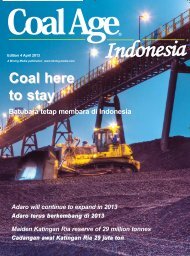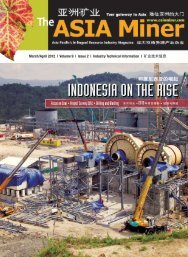May/June 2013 - The ASIA Miner
May/June 2013 - The ASIA Miner
May/June 2013 - The ASIA Miner
You also want an ePaper? Increase the reach of your titles
YUMPU automatically turns print PDFs into web optimized ePapers that Google loves.
Mining Success Stories<br />
<strong>The</strong> community is kept well informed about Ballarat operations through consultative committees and regular open days.<br />
but Lihir was getting half that and the economics<br />
were not there, so they ran the ‘For<br />
Sale’ flag up the pole in 2009.<br />
“Meanwhile, up the road Castlemaine Goldfields<br />
was watching this unfold and threw<br />
their hat in the ring when they saw it was for<br />
sale. Castlemaine made a non-binding bid of<br />
a value a number of times more than its market<br />
capitalization. Lihir was trying to sell as a<br />
big company does with a data room of information<br />
and all the things you would expect<br />
to attract interest but it was the GFC and<br />
people were keeping their hands in their<br />
pockets. At the time Bendigo Mining was<br />
having problems and if Lihir couldn’t make<br />
Ballarat work, people queried what were its<br />
chances of success.<br />
“<strong>The</strong>re was very little interest and Castlemaine<br />
was successful, paying $4.5 million in<br />
cash, which represented 1 cent in the dollar<br />
for Lihir’s investment. Castlemaine backed<br />
the environmental guarantee with a $4 million<br />
bond to the government and there is a 2.5%<br />
net smelter royalty, capped at $50 million,<br />
now payable to Newcrest, which bought Lihir.<br />
<strong>The</strong> sale included $1 million in stores inventory<br />
and a team of 6 people from Lihir, and<br />
Castlemaine then sold more than $2 million<br />
worth of surplus plant and equipment. It was<br />
a transformational year for Castlemaine, moving<br />
from small explorer to a near-term producer<br />
and there are not too many juniors that<br />
can boast a head-start into being a near-term<br />
producer like we received, picking up plant,<br />
infrastructure, permits, licence, the whole lot.”<br />
A different strategy<br />
Matthew Gill says Castlemaine was never<br />
going to take up the Lihir strategy and saw<br />
that you could spend a lot of money to produce<br />
a lot of ounces but the amount of profit<br />
could be quite small. “We decided to aim for<br />
quality over quantity, to be a 50,000<br />
ounce/annum producer not 200,000 ounces,<br />
to treat 220,000 tonnes/annum not 600,000<br />
tonnes and to run the mill three days a week.<br />
Our key focus was to ensure the yield – the<br />
gold grade of the ore – was as high as reasonably<br />
achievable, delivering a good margin<br />
between the cost of mining and the revenue<br />
received from sale of the gold.<br />
“We put two drill rigs underground and<br />
drilled for nine months to determine that there<br />
was enough mineralization for at least two<br />
years. <strong>The</strong> rigs are drilling as we go because<br />
it’s not possible to drill from surface owing to<br />
the mine being more than 600 metres underneath<br />
the city. We drill for structure as it’s problematic<br />
to fully drill out a resource above the<br />
inferred category, and this gives us a rolling 2-<br />
year mine life. Working to a 5-year mine life<br />
would mean spending tens of millions and this<br />
is not the space Castlemaine is in. We need to<br />
justify where we spend capital and are now<br />
extending the tails dam – this next stage will<br />
add another 2 years storage capacity because<br />
we believe this gold-bearing system will keep<br />
going to the north with at least 1.5km ahead of<br />
the 3.5km we have already advanced and<br />
which has yielded 1.5 million ounces to date<br />
from underground. <strong>The</strong> structural continuity<br />
and robustness of what we have mined to<br />
date supports this expenditure.”<br />
Castlemaine Goldfields completed its ninemonth<br />
drill program, conducted its own feasibility<br />
study, and commenced mining<br />
underground at Ballarat in March 2011 by extending<br />
the decline, mined its first gold bearing<br />
ore mid-year, poured first gold in<br />
September 2011 and ramped up to steadystate<br />
production by mid-2012. Matthew Gill is<br />
proud to state, “From acquisition to gold producer<br />
in 18 months is a tremendous credit to<br />
our workforce and support from the community,<br />
local authorities and shareholders.”<br />
He says, “Exploration is important and we<br />
are drilling underground at Ballarat as well as<br />
regionally. We have a processing mill that is<br />
more than twice the capacity of what we are<br />
using so if we can discover other deposits we<br />
have the spare capacity. What we are doing<br />
shows there is room for small players as the<br />
50,000 ounces produced annually would not<br />
interest big players. With cash operating<br />
costs under $1000 an ounce, it’s not a bad<br />
margin at current gold prices and a lot of juniors<br />
would be happy with that.<br />
“If the Chewton drilling upgrades the resource<br />
we will consider a feasibility study for<br />
underground operations, but this is some<br />
years away. To complement the timeline, Tarnagulla<br />
has near-surface open pit potential.<br />
We are doing soil and augur sampling, and<br />
planning RC drilling. <strong>The</strong> turnaround should<br />
be a lot quicker than an underground operation,<br />
even considering environmental and<br />
permitting issues.<br />
“We are also planning preliminary drilling from<br />
underground to intersect the Ballarat West<br />
goldfield, about 1.5km west of the mine. It produced<br />
almost 1 million ounces in its own right<br />
at twice the gold grade of the Ballarat East field<br />
where we are working now. It’s on our<br />
doorstep and has potential to be accessed<br />
from current underground operations. We have<br />
potential north, which is where we are heading,<br />
we will test west and 25km away to our<br />
south is Berringa which was mined until the<br />
1980s and has possibilities as an underground<br />
operation and potential source of mill feed.”<br />
<strong>The</strong> Ballarat Goldfield has produced about<br />
12 million ounces since the 1850s and if<br />
Castlemaine and Tarnagulla are added, is the<br />
fourth most prospective gold holding in Australia<br />
behind Bendigo, Kalgoorlie’s Super Pit<br />
and Boddington. “While past performance is<br />
no guarantee of future performance,”<br />
Matthew Gill says, “we’ve got tenements that<br />
6 | <strong>ASIA</strong> <strong>Miner</strong> | <strong>May</strong>/<strong>June</strong> <strong>2013</strong>



